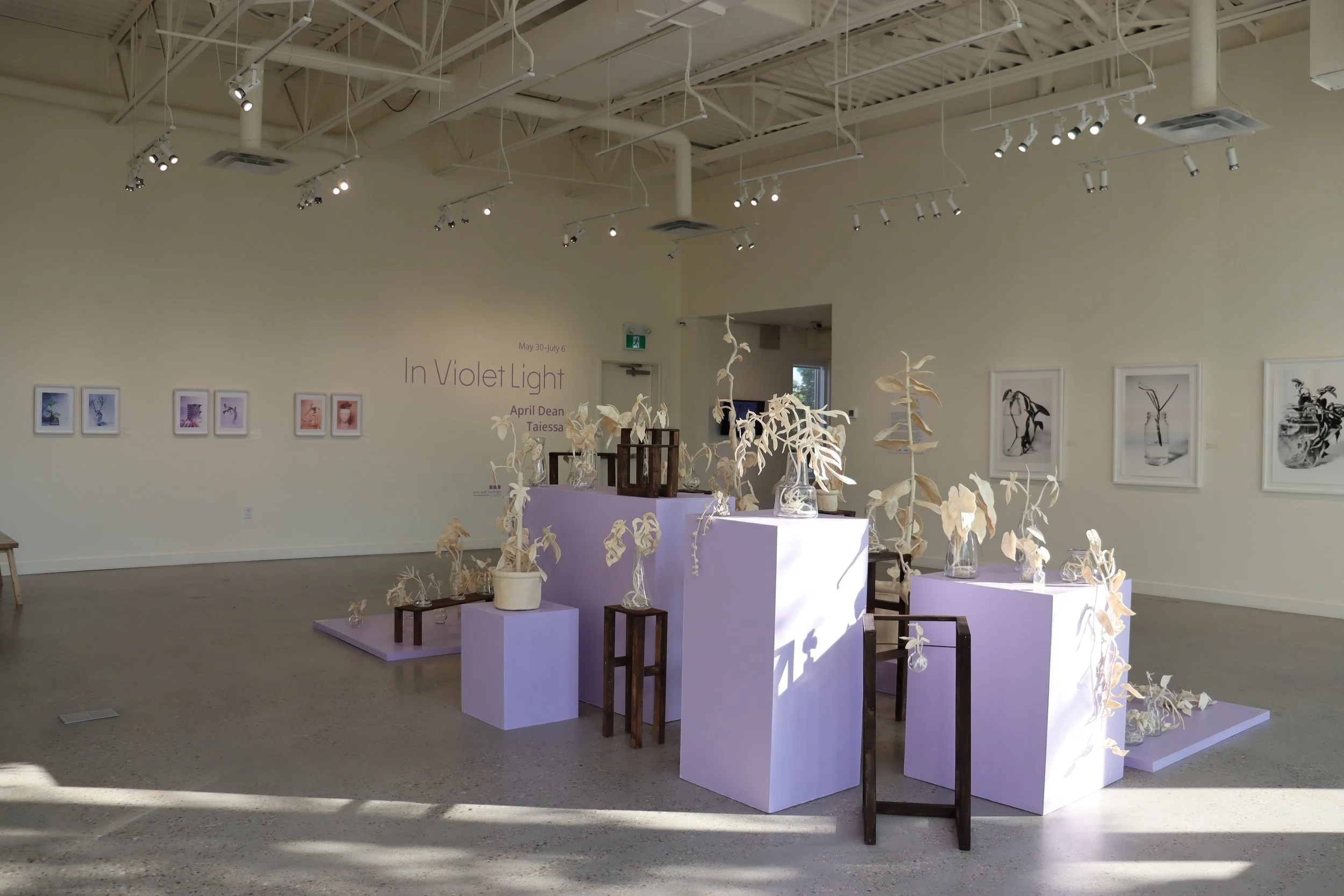Install shot of variegata, featured in In Violet Light at The Art Gallery of St. Albert. Photograph courtesy of the gallery.
The collection and cultivation of rare plants is a centuries-old practice. Historically, colonial powers’ greenhouses and gardens served as grounds to exercise dominance over land and its resources. Throughout the course of European imperial expansion in the 17th and 18th centuries, plant species were transplanted from their native habitats with varying levels of success, and with varying levels of respect for local and Indigenous knowledge systems. Not only were they studied for their medicinal capabilities and other useful properties, but their collection and display became a symbol of status.
In the ongoing series variegata, I am interested in examining the commercialization of plant collecting as tied to colonial extraction, continuing to serve as an accrual of social capital in contemporary times. A current trend in the still-booming exotic plant market dictates not only the species of plant, but its mutation. While many plants have variegation - simply, more than one colour present in their foliage - certain cultivars with chimeral variegation have become highly desirable. Marked by white or cream-coloured splashes punctuating otherwise green foliage, these variegations can increase the selling price of plant clippings by hundreds of dollars.
variegata is a projection of the windowsill, the plant nursery, the commercial and residential greenhouses’ future if current botanical trends are continually prioritized and selected for in growing practices. It is an exercise in and examination of futility, in that the key feature of chimeral variegations is that the cream-coloured plant tissues are of that hue due to their inability to produce chlorophyll. This genetic mutation emphasizes the ephemeral nature of plant life - not only will it cycle through growth and decay as an organic material, but it is certain to do so sooner as it lacks the chromosomes necessary to sustain its own life.
As art objects made from inert materials, these sculptures actively resist ephemerality in direct contrast to the plant life they mimic. The hand-made plants in this series, wryly displayed in glass vials designed for propagation, act as mementos. Much like the colonial and imperialist history of plant-collecting, this imagining relegates plant life to trophies to be amassed. Complicating this, however, is the methodology. Like living plants requiring investments of time and care to thrive, these sculptures have been made through laborious craft practices including appliqué, sewing, and felting. Together, this display questions flora as capital rather than life ripe with histories and knowledges to be appreciated and learned from, and beckons for more equitable forms of exchange.
Art Gallery of Alberta, 2025
Esker Foundation, 2024-25
Read feature in the Globe and Mail here.
Art Gallery of St. Albert, 2024
Read feature in the Edmonton Journal here.
In Violet Light, curated by Emily Baker. Photograph by Art Gallery of St. Albert.
Harcourt House Artist Run Centre, 2023
Read Freyja Catton’s review here.























Soft Gallery, 2023
Photograph by Spencer Vandermeer.
Latitude 53, 2022
variegata was made in support through Harcourt House Artist Run Centre's Artist in Residence Program.
This project is generously funded by the Edmonton Arts Council, the City of Edmonton, and the Alberta Foundation for the Arts.
References:
Chandra Mukerji, “Dominion, Demonstration, and Domination: Religious Doctrine, Territorial Politics, and French Plant Collection,” in Colonial Botany Science, Commerce, and Politics in the Early Modern World, ed. Londa Schiebinger and Claudia Swan. (Philadelphia: University Of Pennsylvania Press, 2016), 19-33.
Kimmerer, Robin Wall. 2015. Braiding Sweetgrass. Minneapolis, MN: Milkweed Editions.
























